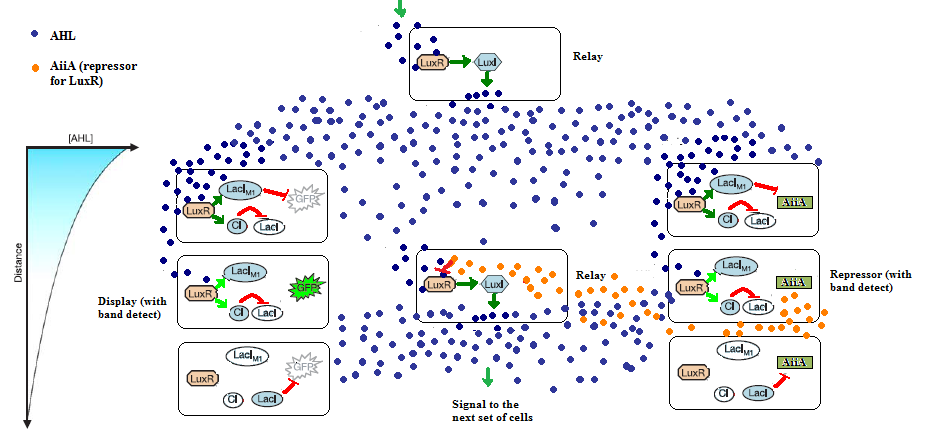Team:Uppsala-SwedenProject
From 2010.igem.org



Project Description:
Our project for iGEM 2010 involves building a biological concentration band detection sensor and demonstrating its usefulness in building a bio-clock and color display unit.
The concentration band detection mechanism makes use of a pair of of promoters with different efficiencies to detect the quantitative value of the input signal.
Figure 1:Schematic showing quorum sensing behaviour and responses which relate to band detect. Adapted from Basu S et.al, 2005.
Band Detect:
Previous Work
Being an engineering competition iGEM promotes building on previous projects.The Cambridge 2007 and 2009 teams built upon each other to produce the Sensitivity Tuner using phage activators and promoters.These Sensitivity Tuner's can detect different levels of a input signal and generate a corresponding output. You can find details of how the teams built and characterised their parts in the last years website.
Detecting specific Bands or concentration ranges
The sensitivity tuners do a pretty good job of detecting a signal above certain specific values each. However, they will still get activated when the next sensitivity tuner detects the input signal. For example, the construct [http://partsregistry.org/wiki/index.php/Part:BBa_I746370 BBa_I746370] will start detecting at 0.85 uM while the construct [http://partsregistry.org/wiki/index.php/Part:BBa_I746371 BBa_I746371] will start detecting at 0.92 uM. Both the constructs will detect the input signal at say 0.95 uM. Although this is good enough for detecting chemical concentrations, it will have to be able to detect specific bands to be able to perform concentration band specific actions.
The below diagram explains how we plan to use two sensitivity tuners in combination to get the band detect behaviour.The sensitivity tuners which detect different levels of the input signal will repress the output at levels below or above the band detect.
Proof Of Concept and Characterisation:
Under Construction
References:
1.Basu S, Gerchman Y, Collins C.H, Arnold F.H, Weiss R, A synthetic multicellular system for programmed pattern formation, 2005, Nature, Vol 434, 1130-1134.
2.Danino T, Mondragón-Palomino O, Tsimring L, Hasty J, A synchronized quorum of genetic clocks, 2010, Nature, Vol 463(7279): 301-2.
 "
"

